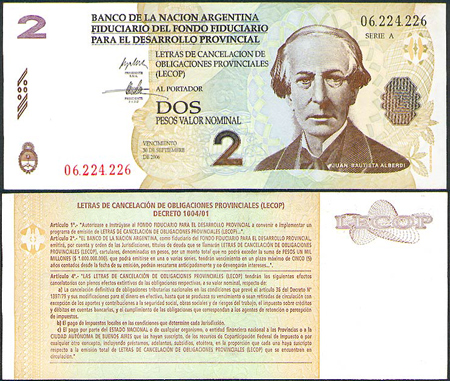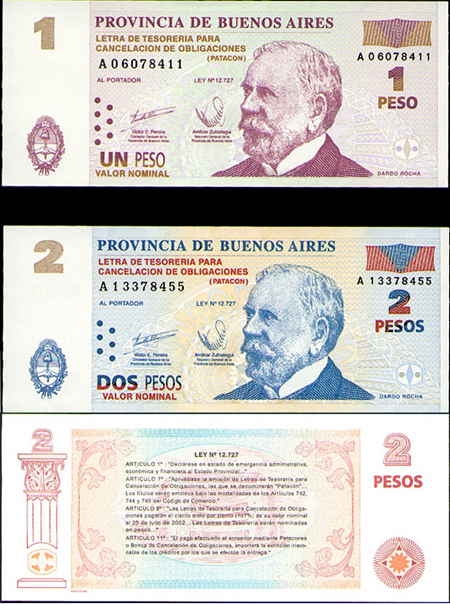
This glossary accompanied the Argentina Experienced website (and later the abroad: ramblings from robert blog) in order to help readers understand terminology related to the 2001 crisis. Living through that period gave me a crash course in economics & local slang. Dive in!
Arbolito • • • Literally “little tree” since they stand in the same spot for so long. Slang for a person who offers unofficial currency exchange on the street.
Cacerolazo • • • “Big casserole” or “large pot,” this term refers to a form of middle-class protest which began during the Alfonsín era & reappeared in December 2001. During a cacerolazo, people make whatever noise they can by banging on pots & pans, balconies, street poles, clapping, honking car horns, beating on drums —basically whatever is available. This often involves blocking key traffic intersections & in Buenos Aires, a march to Plaza de Mayo. A cacerolazo shows solidarity with others in your neighborhood & is a non-violent form of protest.
CER • • • Coeficiente de Estabilización de Referencia, or Referenced Coefficient for Real Value Stabilization. This number is based on the Consumer Price Index from the previous two months + the first 6 days of the current month & takes into account the effect of inflation on all prices. The CER varies from day to day, & the Central Bank publishes tables for public reference. During the first half of 2001, the CER was used to calculate rents & mortgages after devaluation. For example, my previous rent had been set at $340 pesos by contract, but after multiplying by the CER of 08 Mar 2001 when I paid, it was $348 [$340 x 1.0244 = $348.30].
Chorro • • • Argentine slang for “thief.”
La City • • • A reference to the financial district of London, this area of Buenos Aires contains the central offices of all banks in Argentina. Prior site of daily protests & part of the microcentro.
Corralito • • • A “little corral” refers to the government-sponsored partial freezing of all bank accounts from December 2001 to December 2002. An effort to block capital flight by Economic Minister Domingo Cavallo, the corralito sparked all manner of protests. It was modified several times since being put into effect, but the general premise was that only $1200 per month could be withdrawn in maximum increments of $300 per week. The government claims most Argentines make that amount per month on average, so spending power can be maintained. If your weekly limit is not withdrawn, the balance is carried over to the next week. Additional transactions over the $1200 monthly cash limit were to be covered by debit or credit card. As a result of not having free access to bank accounts, people were afraid to spend whatever cash they had on hand for fear of not having any available by the end of the week. Also, small businesses had to raise prices in order to afford verification machines & bank fees associated with plastic transactions. Amazingly long lines formed at banks as people rushed to withdraw whatever funds they could, and confidence in the peso disappeared.
Corralón • • • This “big corral” is where most Argentines cash remains. The term refers to the forced reprogramming of dollar deposits to plazo fijos. Even though the corralito ended in December 2002, the corralón still holds about half of all available cash in Argentina. Many hope that the Supreme Court will to find a way to re-dollarize these deposits.
Desaparecidos • • • Literally “people who have disappeared,” this general term is used for the estimated 30,000 people who were tortured & killed during the military dictatorship of 1976-1983. Most families still do not have official information as to what happened to their missing relatives. The Mothers of Plaza de Mayo, known for wearing white scarves over their heads, continue to march weekly in demand for release of additional information. Two good representations of events during that time are La Historia Oficial which won an Oscar in 1986 for Best Foreign Film & Garage Olímpico from 1999.
Escrache • • • Argentine slang for a public denouncement. The term first appeared in the 90s when former President Menem pardoned army personnel responsible for the torture & murder of Argentines during the military dictatorship of 1976-1983. Family members of the desaparecidos would gather outside the home of the freed military personnel & make noise, shout, scream & protest —usually for several days without stopping. The escrache was revived for Economic Minister Cavallo after he resigned & was also used at banks in the microcentro as a protest against the corralito.
INDEC • • • Instituto Nacional de Estadística y Censos, or National Institute for Statistics and Censuses. Government organization responsible for compiling economic & social statistics.
Lecop • • • Letras de Cancelación de Obligaciones Provinciales, or Notes for Cancelling Provincial Debt. Bonds issued as currency by most provinces in Argentina. Of over U$S 4 billion of bonds that have been printed in the last year, Lecops constitute about half this amount. While all provinces have the authority to issue Lecops, many have begun to print bonds of their own (like the federal in Entre Ríos). They are accepted in many places in Buenos Aires in lieu of pesos:

Microcentro • • • What would be called “downtown” in the USA, this area in Buenos Aires is composed of mainly businesses, banks & retail. This mini, unofficial barrio coincides with central sections of the neighorhoods of San Nicolás & Montserrat.
Patacón • • • Bonds issued as currency only by the province of Buenos Aires. These are widely accepted in the city of Buenos Aires:

Peso • • • Official currency of Argentina since 1991, the peso was pegged at a rate of 1 to 1 with the US dollar until devaluation in January 2002. At that moment, the exchange rate was split among an official peso pegged at U$S 1.40 and a free market peso. In February 2002, the peso was allowed to exchange on the free market completely and hovers at $3.50 = U$S 1. Due to 1:1 convertibility, the dollar sign ($) was adopted as the monetary symbol. US dollars are differentiated from pesos by using the symbol U$S.

Pesificar • • • A new word in the Spanish lexicon which means converting dollars to pesos.
Plazo fijo • • • Local term for CD, or Certificate of Deposit. Before the corralito, interest rates were at a level unheard of in the US, reaching an annual average of 12% for pesos and 8% for dollars.